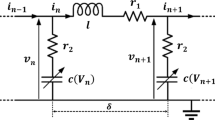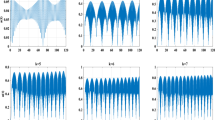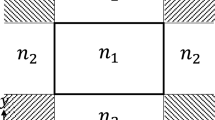Abstract
A finite-difference method is used to solve the nonlinear Schrödinger equation. A not frequently used numerical method is developed by replacing the time end space derivate by central-difference replacements. Results from solving the nonlinear Schrödinger equation by using the numerical method called method of lines are used to simulate the propagation of Gaussian pulses in optical fibers. Gaussian input pulse was used for the analysis of dispersion effects. For the simulation was chosen the nonlinear Schrödinger equation modified for dispersion mode. Based on the changes of the chirp parameter have been achieved final shapes of transmitted Gaussian pulses. The main objective was to demonstrate the impact of the broadening factor of the pulse and also to clarify the correlation between the change in phase and frequency chirp. The main goal of this paper is to describe and simulate effects of dispersion by using short Gaussian and hyperbolic secant optical pulses. The effect of dispersion caused frequency shift which can be compensated by effect of self-phase modulation. Frequency chirp caused by the dispersion effects can be compensated by generating opposite frequency chirp with SPM effect. This compensation can lead to fundamental soliton pulse shape generation. Temporal solitons are attractive for optical communications because they are able to maintain their width even in presence of fiber dispersion. Only a fundamental soliton maintains its shape and remains chirp-free during propagation inside optical fibers.







Similar content being viewed by others
References
Agrawal, G.P.: Fiber–Optic Communication Systems, 3rd edn. Wiley publication, New Jersey (2002)
Agrawal, G.P., Kelley, P.L., Kaminow, I.P.: Nonlinear Fiber Optics, 3rd edn. Academics Press (2001)
Alcon-Camas, M., El-Taher, A.S.E., Wang, H., Harper, P., Karalekas, V., Harrison, J.A., Ania-Castanon, J.D.: Ultralong raman fiber lasers as virtually lossless optical media. Opt. Lett. 363–369 (2009)
Atluri, S.N., Liu, H.T., Han, Z.D.: Meshless local Petrov–Galerkin (MLPG) mixed finite difference method for solid mechanics. Tech. Sci. Press CMES 15(1), 1–16 (2006)
Cui, M.: Compact finite difference method for the fractional diffusion equation. J. Comput. Phys. 228, 7792–7804 (2009)
Deng, Y., Deng, S., Tan, C., Xiong, C., Zhang, G., Tian, Y.: Study on propagation characteristics of temporal soliton in Scarff II PT-symmetric potential based on intensity moments. Opt. Laser Technol. 79, 32–36 (2016)
Griffiths, D.F., Mitchell, A.R., Morris, J.L.: A numerical study of the nonlinear Schrödinger equation. Comput. Methods. Appl. Mech. Eng. 45, 177–215 (1984)
Ismail, M.S., Taha, T.R.: Numerical simulation of coupled nonlinear Schrödinger equations. Math. Comput. Simul. 56, Elsevier, 547–562, (2001)
Kim, J., Cox, J., Chen, J., Kärtner, F.X.: Attosecond-resolution timing jitter characterization of free-running modelocked lasers. Opt. Lett. 32, 3519–3521 (2007)
Kivshar, Yu. S.: Nonlinear Tamm states and surface effects in periodic photonic structures. Laser Phys. Let. 5(10), 703–713 (2008)
Liling, Y., Shouhuan, Z., Guoying, F., Kui, L.: The study on supercontinuum generation of femtosecond pulse propagating in condensed media. Photonics Optoelectron. (SOPO)4964-4, 19–21 (2010)
Nguimdo, R.M.: Effect of fiber dispersion on broadband chaos communications implemented by electro-optic nonlinear delay phase dynamics. J. Lightwave Technol. 20, 1–8 (2010)
Poboril, R., Latal, J., Koudelka, P., Vitasek, J., Siska, P., Skapa, J., Vasinek, V.: A concept of a hybrid WDM/TDM topology using the Fabry–Perot laser in the optiwave simulation environment. Adv. Electr. Electron. Eng. 9(4), 167–178 (2011)
Sadiku, M.N.O., Obiozor, C.A.N.: A simple introduction to the method of lines. Int. J. Electr. Eng. Edu. 37(3), 282–296 (2000)
Scholtz, L., Korcek, D., Ladanyi, L., Mullerova, J.: Tunable thin film filters for the next generation PON stage 2 (NG-PON2). Elektro 2014, 98–102 (2014)
Twizell, E.H., Bratsos, A.G., Newby, J.C.: A finite-difference method for solving the cubic Schrödinger equation. Math. Comput. Simul. (1997). doi:10.1016/S0378-4754(96)00056-0
Weideman, J.A.C., Herbst, B.M.: Split-step methods for solution of the nonlinear Schrödinger equation. Numer. Anal. 485–507 (1986)
Acknowledgements
This work was partly supported by the Slovak Research and Development Agency under the project APVV-0025-12 and by the R&D operational programme Centre of Excellence of Power Electronics Systems and Materials for their Components No. OPVaV-2008/2.1/01-SORO, ITMS 2622012003 funded by European Community.
Author information
Authors and Affiliations
Corresponding author
Additional information
This article is part of the topical collection on optical wave and waveguide theory and numerical modelling 2016.
Guest edited by Krzysztof Anders, Xuesong Meng, Gregory Morozov, Sendy Phang, and Mariusz Zdanowicz.
Rights and permissions
About this article
Cite this article
Ladányi, L., Scholtz, Ľ. & Müllerová, J. Numerical simulations of dispersion effects in chirped Gaussian and soliton pulses. Opt Quant Electron 49, 105 (2017). https://doi.org/10.1007/s11082-017-0937-3
Received:
Accepted:
Published:
DOI: https://doi.org/10.1007/s11082-017-0937-3




